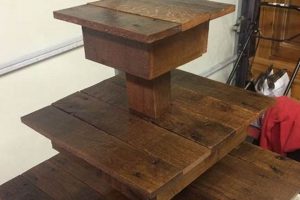A do-it-yourself solution for propping up a tablet device typically involves constructing a supporting structure from readily available materials. Such projects range from simple, folded cardboard designs to more complex fabrications using wood, metal, or plastic. The primary function is to provide a stable and adjustable platform for hands-free tablet use. For example, a user might create a stand from repurposed book covers and a hinged mechanism to view recipes while cooking.
The creation of personalized tablet supports provides several advantages. It offers a cost-effective alternative to commercially manufactured products, allows for customization to meet specific ergonomic needs or aesthetic preferences, and promotes resourcefulness through the reuse of materials. Historically, individuals have adapted everyday objects to support reading materials; the current application extends this practice to accommodate modern technology.
The subsequent sections will detail various construction methods, material options, and design considerations for building a customized tablet support. Furthermore, factors impacting stability, adjustability, and overall usability will be explored, enabling the reader to create a functional and personalized device accessory.
Construction and Design Tips
The following tips offer guidance in the construction and design of a customized tablet support, emphasizing functionality, stability, and material selection.
Tip 1: Material Selection is Paramount: Consider the tablet’s weight and size when selecting materials. Sturdy options like wood or metal provide enhanced stability, while lightweight materials such as acrylic or durable plastics can offer portability. Proper material preparation, including sanding or deburring, is crucial for a smooth finish and user safety.
Tip 2: Prioritize a Stable Base: A wide and balanced base prevents tipping. Implement non-slip materials like rubber feet or adhesive pads to further enhance stability, especially on smooth surfaces. Distribute the weight evenly across the base to avoid instability issues.
Tip 3: Incorporate Angle Adjustability: Design a mechanism for adjusting the viewing angle. Hinges, notches, or ratcheting systems allow users to customize the angle for optimal ergonomics and minimize glare. Ensure the adjustment mechanism is secure and maintains the selected angle under the tablet’s weight.
Tip 4: Account for Charging Access: Plan for unobstructed access to the tablet’s charging port. Cutouts or open designs allow charging while the tablet is in use. Consider cable management solutions to prevent tangling and maintain a tidy workspace.
Tip 5: Consider Portability: If portability is a requirement, design a foldable or easily disassembled stand. Use lightweight materials and a compact design for convenient storage and transport. Secure hinges or locking mechanisms prevent accidental unfolding during transit.
Tip 6: Test for Compatibility: Before finalizing the design, thoroughly test the stand with the intended tablet model. Ensure proper fit, stability, and access to all ports and buttons. Make adjustments as needed to optimize functionality.
Tip 7: Implement Secure Tablet Retention: Consider methods to securely hold the tablet within the stand. Raised edges, clips, or elastic straps prevent accidental slippage. Ensure the retention mechanism does not obstruct the screen or interfere with button operation.
Adhering to these guidelines facilitates the creation of a personalized tablet support that effectively addresses individual needs and preferences, enhancing usability and comfort.
The concluding section will summarize the benefits of constructing a customized tablet support and provide suggestions for further exploration of related projects.
1. Stability
Stability is a foundational requirement for a functional do-it-yourself tablet support. Without a stable base and structure, the tablet is prone to tipping, potentially damaging the device and disrupting its intended use. The connection between the two is direct and causal: inadequate stability renders the stand effectively unusable. The importance of stability is highlighted by its role in enabling hands-free operation. A stand that consistently topples over necessitates manual intervention, negating the ergonomic benefits and intended convenience.
The design of a stable support requires consideration of several factors. These include the weight and dimensions of the tablet, the chosen material’s strength and rigidity, and the distribution of weight across the base. A real-world example demonstrates this principle: a stand constructed from thin cardboard with a narrow base is likely to be unstable under the weight of a larger tablet, whereas a stand crafted from wood with a wider base and lower center of gravity provides a significantly more secure foundation. The practical significance of understanding stability is evidenced by the reduced risk of damage to the tablet and the enhanced user experience resulting from reliable support.
In summary, stability is an indispensable component of any do-it-yourself tablet support. Its absence compromises the device’s safety and diminishes its utility. By carefully considering the factors that contribute to stability during design and construction, individuals can create effective and reliable tablet stands that meet their specific needs and usage scenarios. Overcoming challenges in achieving stability, such as selecting appropriate materials and designing a balanced structure, is key to realizing the full potential of a self-made tablet support.
2. Adjustability
Adjustability represents a critical design consideration in the context of creating a do-it-yourself tablet stand. The capacity to modify the viewing angle and height contributes significantly to user comfort, ergonomic posture, and overall utility of the stand. A fixed-position stand inherently limits the user’s ability to optimize the tablet’s display for various lighting conditions and viewing preferences.
- Viewing Angle Customization
This facet focuses on the ability to alter the angle of the tablet relative to the user’s line of sight. Adjustable hinges, ratcheting mechanisms, or slotted designs allow for a range of viewing angles, accommodating different seating arrangements and minimizing screen glare. For instance, a drafting table hinge integrated into a wooden stand provides precise angle control for detailed work. This directly impacts user comfort and reduces eye strain.
- Height Modification
Altering the height of the tablet elevates the screen to a more ergonomically sound position, reducing neck strain. This can be achieved through telescoping supports, stacking elements, or adjustable legs. A stand that allows the tablet to be raised to eye level promotes better posture and prevents slouching. This feature is particularly beneficial for extended use periods.
- Orientation Flexibility
The ability to easily switch between portrait and landscape orientations offers adaptability for various applications. A rotating base or a design that allows the tablet to be quickly re-positioned facilitates this functionality. Consider a design utilizing a lazy susan bearing as the base to smoothly switch between portrait and landscape modes. This is crucial for reading documents, watching videos, or engaging in video calls.
- Stability at Various Adjustments
Maintaining stability across the entire range of adjustments is paramount. The design must ensure that the stand remains stable and does not tip over when adjusted to different angles or heights. A wider base and robust locking mechanisms contribute to stability. For example, a stand utilizing a system of locking pins or friction joints must reliably maintain the selected configuration. Compromised stability negates the benefits of adjustability.
These adjustable features, when incorporated into a do-it-yourself tablet stand, enhance its functionality and usability, adapting to the individual needs and preferences of the user. The successful implementation of adjustability requires careful design and construction, ensuring both flexibility and stability are maintained. The absence of such features diminishes the value of a customized tablet support.
3. Material Selection
Material selection exerts a direct and significant influence on the overall functionality and longevity of a do-it-yourself tablet stand. The chosen material dictates structural integrity, aesthetic appeal, and the range of fabrication techniques applicable to the project. For instance, utilizing lightweight materials such as PVC pipe facilitates the construction of portable stands, while hardwoods like oak or maple provide increased durability and visual sophistication, albeit with a corresponding increase in weight and complexity of fabrication. A flawed material choice can result in a stand that is structurally unsound, aesthetically unappealing, or unsuitable for the intended environment.
The practical implications of informed material selection are evident in several design aspects. A stand intended for kitchen use may benefit from water-resistant materials like stainless steel or sealed wood, preventing damage from spills. A stand designed for frequent transport necessitates lightweight yet durable materials such as aluminum or high-density polyethylene (HDPE). The selection process must also account for the tablet’s dimensions and weight; heavier tablets require materials with greater load-bearing capacity to ensure stability. Failure to consider these factors can lead to structural failure or an unstable user experience.
In conclusion, judicious material selection is paramount in the creation of a functional and enduring do-it-yourself tablet stand. It is not merely a superficial consideration, but rather a fundamental determinant of the stand’s structural integrity, aesthetic value, and suitability for its intended purpose. Challenges related to material selection can be mitigated through thorough research, careful consideration of design requirements, and a realistic assessment of available fabrication resources, thereby maximizing the potential of the project and extending its lifespan.
4. Ergonomics
Ergonomics plays a pivotal role in the design and utilization of self-constructed tablet supports. Neglecting ergonomic principles can lead to physical discomfort, strain injuries, and reduced productivity. Conversely, incorporating ergonomic considerations optimizes the user experience, promoting a more comfortable and efficient work environment. A thoughtfully designed stand directly mitigates potential physical strain associated with prolonged tablet use.
- Neck Strain Reduction
Elevating the tablet screen to eye level minimizes the downward head tilt that often accompanies tablet use. A self-made stand can be customized to achieve this optimal height, thereby reducing strain on the neck muscles and preventing related discomfort. An example includes a stand designed to hold the tablet at a 15-20 degree angle, mimicking a natural reading posture. This reduces the likelihood of developing “tech neck,” a common ailment associated with prolonged device use.
- Wrist and Hand Positioning
An ergonomically sound stand facilitates a neutral wrist posture during tablet interaction. This is particularly relevant when using the touchscreen or an external keyboard. A stand that allows for tilting the tablet can minimize wrist extension or flexion, reducing the risk of carpal tunnel syndrome and other repetitive strain injuries. Consideration should be given to the angle and proximity of the screen to allow comfortable use for extended periods.
- Posture Improvement
By promoting a more upright posture, a well-designed stand minimizes slouching and spinal compression. This can lead to improved breathing and reduced back pain. A stand that supports the tablet at a comfortable viewing distance and angle encourages a more natural and balanced posture, minimizing the strain on spinal discs and supporting muscles. The implications of improved posture extend beyond comfort, positively influencing overall health and well-being.
- Customizable Comfort
The ability to personalize a stand’s dimensions and features allows for a highly tailored ergonomic solution. Individual needs and preferences can be accommodated, maximizing comfort and efficiency. A self-constructed stand offers the opportunity to incorporate features such as adjustable height, tilt, and rotation, catering to specific body types and task requirements. This level of customization cannot be readily achieved with commercially available, one-size-fits-all products.
Integrating these ergonomic considerations into the design process of a self-made tablet support contributes significantly to a more comfortable, healthy, and productive user experience. A stand that prioritizes ergonomic principles represents a proactive approach to preventing musculoskeletal issues associated with prolonged tablet use. Ultimately, a well-designed stand seamlessly blends functionality and comfort, enhancing the overall utility of the device.
5. Port Access
The design of a self-constructed tablet support necessitates careful consideration of port access. This feature directly influences the device’s usability by enabling simultaneous charging and accessory connection while the tablet is secured within the stand. Unobstructed access to the charging port and other interfaces is crucial for maintaining uninterrupted operation and expanding the tablet’s functionality. A design that overlooks port access compromises the user experience and limits the device’s practical application. For example, a stand that covers the charging port renders the tablet unusable while mounted, requiring frequent removal for battery replenishment.
Effective integration of port access involves strategic placement of cutouts or open areas in the stand’s structure. This design consideration requires accounting for the specific port locations on the intended tablet model. Furthermore, the design must accommodate various cable types and connector sizes, ensuring compatibility with a range of accessories. A practical example involves creating a channel or recess within the stand to route charging cables, preventing interference with the tablet’s screen or buttons. The incorporation of a universal design approach, accommodating multiple tablet models, increases the stand’s versatility and longevity.
In summary, port access represents a vital element in the design of a do-it-yourself tablet support. Its inclusion ensures continuous operation and expands the device’s capabilities, while its omission diminishes the stand’s practicality and user satisfaction. A proactive approach to port access considerations, involving careful planning and precise execution, is essential for creating a functional and user-friendly tablet support solution. The benefits of prioritizing port access extend beyond mere convenience, contributing to a more seamless and productive user experience.
6. Tablet Retention
Tablet retention, in the context of self-constructed tablet supports, directly impacts the security and usability of the device. Inadequate tablet retention mechanisms can lead to accidental slippage or falls, potentially damaging the tablet and disrupting its intended function. The cause-and-effect relationship is clear: insufficient retention results in device instability. The importance of robust tablet retention cannot be overstated, as it serves as a primary safeguard against damage and ensures a consistent, hands-free user experience. A real-life example includes a stand constructed with smooth, untextured surfaces, lacking any form of securing mechanism; such a design readily allows the tablet to slide off, particularly when the stand is tilted or subjected to minor vibrations. Understanding this connection is practically significant for designers seeking to create functional and reliable supports.
Various methods can be employed to enhance tablet retention in do-it-yourself designs. These include incorporating raised edges, strategically placed clips or brackets, and utilizing friction-enhancing materials such as rubber or silicone. The choice of retention method depends on factors such as the tablet’s dimensions, the stand’s overall design, and the desired level of security. For instance, a minimalist stand might rely on a combination of raised edges and a non-slip surface, while a more robust design could incorporate adjustable clips to accommodate different tablet sizes. The effectiveness of each method should be thoroughly tested to ensure adequate retention under varying conditions, including tilted orientations and minor impacts. Failure to adequately test retention mechanisms can lead to device instability and potential damage.
In summary, tablet retention is an indispensable component of a well-designed do-it-yourself tablet stand. Its absence compromises the device’s security and diminishes its overall utility. Challenges in achieving effective retention can be overcome through careful consideration of design, material selection, and thorough testing. Prioritizing tablet retention translates directly into a more reliable and user-friendly device accessory. Furthermore, a secure retention system safeguards the tablet against damage, extending its lifespan and preserving its functionality.
Frequently Asked Questions
The following addresses common inquiries regarding the design, construction, and functionality of self-made tablet supports. These questions aim to provide clarity and guidance for individuals undertaking such projects.
Question 1: What are the primary considerations when designing a stable do-it-yourself tablet stand?
Achieving stability requires careful attention to the base’s dimensions, material selection, and weight distribution. A wider base provides increased stability, while materials with inherent rigidity, such as wood or metal, minimize the risk of tipping. The tablet’s weight should be evenly distributed across the base to prevent imbalances.
Question 2: How can adjustability be incorporated into a self-made tablet stand without compromising structural integrity?
Adjustability can be achieved through the incorporation of hinges, ratcheting mechanisms, or slotted designs. However, it is crucial to ensure that these adjustable components are robust enough to support the tablet’s weight without collapsing or losing their set position. Reinforcements and locking mechanisms are often necessary.
Question 3: What materials are best suited for constructing a durable and long-lasting tablet stand?
Durable materials include hardwoods like oak or maple, metals such as aluminum or steel, and high-density plastics. The choice of material depends on factors such as the desired aesthetic, the tablet’s weight, and the intended environment. Proper sealing and finishing are essential for protecting the material from moisture and wear.
Question 4: How does ergonomics factor into the design of a comfortable and user-friendly tablet stand?
Ergonomic considerations include adjusting the tablet’s height and viewing angle to minimize neck and eye strain. The design should promote a neutral wrist posture and encourage an upright seating position. Customizable features, such as adjustable height and tilt, allow users to tailor the stand to their individual needs.
Question 5: How can unobstructed port access be ensured in a self-made tablet stand?
Port access can be achieved by strategically placing cutouts or open areas in the stand’s structure. The design should account for the specific port locations on the intended tablet model and accommodate various cable types and connector sizes. A universal design approach, accommodating multiple tablet models, increases the stand’s versatility.
Question 6: What methods are effective for securing a tablet within a self-constructed stand to prevent accidental slippage?
Effective tablet retention methods include incorporating raised edges, strategically placed clips or brackets, and utilizing friction-enhancing materials such as rubber or silicone. The choice of method depends on the tablet’s dimensions, the stand’s design, and the desired level of security.
These answers provide a foundation for understanding the key aspects of designing and constructing a functional and reliable do-it-yourself tablet stand. Careful consideration of these factors contributes significantly to a successful project outcome.
The subsequent section will offer guidance on troubleshooting common issues encountered during the construction process.
Conclusion
This exploration of the do-it-yourself tablet stand has underscored the multifaceted considerations involved in its successful creation. From stability and adjustability to material selection, ergonomics, port access, and tablet retention, each element contributes directly to the device’s overall functionality and user experience. A comprehensive understanding of these factors is essential for crafting a reliable and practical support solution.
The information presented serves as a foundation for informed design and construction. Readers are encouraged to apply these principles thoughtfully, adapting them to specific needs and available resources. The creation of a customized tablet support represents a commitment to enhanced productivity and ergonomic well-being, transforming a commonplace device into a tool optimized for individual use. The pursuit of well-designed, self-made solutions fosters both practicality and innovation.







